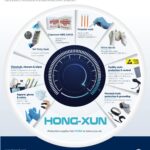In an Electrostatic Discharge (ESD) environment, the choice of cleaning swab is crucial to ensure both effective cleaning and the prevention of electrostatic discharge. Here are the key features to consider when selecting the most effective swab for cleaning in an ESD environment:
Key Features of ESD Swabs
- ESD Protection:
- Conductive Materials: ESD swabs are typically made from conductive or dissipative materials that help prevent the accumulation of static electricity. Common materials include carbon-impregnated foam, polyester, and cotton with conductive fibers.
- Grounding: Many ESD swabs come with a grounding feature that helps to safely dissipate any static charge, ensuring that there’s minimal risk of discharge during cleaning.
- Low Particle Generation:
- ESD swabs should produce minimal particles during use to avoid contaminating sensitive electronic components. Look for swabs designed specifically for cleanroom or ESD applications, which are engineered to reduce linting and particle generation.
- Chemical Compatibility:
- The materials used in ESD swabs should be compatible with cleaning solutions commonly used in ESD environments, such as isopropyl alcohol (IPA) or other solvents. This ensures that the swabs do not degrade or release harmful residues during cleaning.
- Swab Head Design:
- Swabs may come in various head shapes and sizes, such as foam, polyester, or woven fabric. The choice of head design should depend on the specific cleaning task—larger heads for broad surfaces and smaller heads for precision cleaning of tight spaces.
- Non-Conductive Core:
- While the head should be conductive or dissipative, the swab’s stick or handle can be made from a non-conductive material to help minimize the risk of transferring static charge during cleaning.
Recommended ESD Swabs
- Foam ESD Swabs:
- Conductive Foam Swabs: Made from open-cell foam that is conductive, these swabs are excellent for cleaning sensitive surfaces and equipment. They provide good absorbency while minimizing particle generation.
- Polyester ESD Swabs:
- Woven Polyester Swabs: These swabs are made from a cleanroom-compatible, low-lint material and are often designed with a static-dissipative handle. They are effective for cleaning delicate surfaces and electronic components.
- Cotton ESD Swabs:
- Conductive Cotton Swabs: While not as common, some swabs feature cotton heads with conductive fibers woven in. These are suitable for applications requiring high absorbency while still being ESD-safe.
Applications in ESD Environments
ESD swabs are commonly used in various industries, including:
- Electronics Manufacturing: Cleaning circuit boards, semiconductor devices, and other electronic components where static charge can damage sensitive parts.
- Cleanrooms: Ensuring that surfaces in cleanroom environments remain free from contamination without introducing static charge.
- Maintenance and Repair: Cleaning delicate equipment and components in ESD-sensitive areas, such as laboratories or production floors.
Conclusion
The most effective swab for cleaning in an ESD environment is one specifically designed with ESD protection features, such as conductive materials, low particle generation, and chemical compatibility. Foam and woven polyester swabs are popular choices due to their effectiveness and safety in preventing electrostatic discharge. By selecting the right swab, organizations can maintain clean and safe ESD-sensitive environments, protecting both equipment and personnel.



